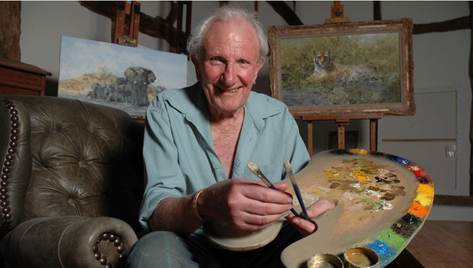Artwork Spotlight: David Shepherd 'Glorious Tiger'
- ella354
- Jan 4, 2024
- 3 min read
Updated: Apr 17, 2024
‘There are few things as beautiful or as threatened as the wild tigers that walk among us.’
- David Shepherd Wildlife Foundation
This painting by David Shepherd has a remarkable history. Painted in 1975, Glorious Tiger was originally made as a gift for the prime minister of India at the time, Mrs Indira Gandhi. It is also likely to be the second tiger subject picture that Shepherd ever made, and the first that he painted after witnessing the animal for the first time in the wild; standing out from the many more which were to follow throughout his illustrious career.
Shepherd first visited the tiger subject in 1973 with his picture Tiger Fire. The purpose behind this work was as a project piece to raise money for the World Wildlife Fund’s ‘Operation Tiger’ by selling a number of prints as limited editions. It raised £127,000 for the cause, standing as just one example of the many conservation endeavours that Shepherd supported during his lifetime and his foundation continues to support to this day. Glorious Tiger was made with a similar purpose, this time to raise money for the tiger within India. During his lifetime, tiger numbers in India had been reduced from 40,000 in 1947 to 1,827 in 1973.[1] Presented to the prime minister in 1975, the picture was a national success and the print run of limited editions went on to raise a further £50,000 for the cause which the artist was so strongly compelled by.
Tigers were to be a subject which the artist would return to repeatedly, to the extent that at one point in his career Shepherd spent half of his time painting tigers. Once when questioned about his favourite animal to see in the wild, he replied ‘The tiger particularly because it is iconic. Once you have seen a tiger in the wild, you never want to see anything else. They are just mind-numbing.’ In the early 1970s, prior to the making of Glorious Tiger and having yet to have seen a tiger in the wild, Shepherd describes his visit to India where, whilst precariously placed sat in a tree, he finally had his first encounter:
We drove to the north of Lucknow, almost to the borders of Nepal, to 'Tiger Haven'. [...] It seemed I might be lucky. There had been two kills the previous night, presumably by separate tigers. I could just make out the dim shape of the kill at the foot of the tree. My heart started bounding every time the jungle stirred, and there are many sounds in the jungle at night. There was all of a sudden a tremendous commotion below the tree and I knew the tiger had arrived. [...] It was a huge male Bengal tiger.
Far from bounding away, he casually looked up, his eyes catching the flashlight like diamonds, and then calmly went on eating. The time was 6.50, and I had the button of the torch pressed until 7.30. They were an exciting forty minutes, and I'd seen my first tiger.[2]
As his first tiger picture to follow this experience, this painting depicting a large male Bengal tiger can be seen as Shepherd’s characterisation of the cat with whom he shared this hair-raising moment. Basking in the sun at the base of small bush or tree, the animal directs his gaze towards us standing as the viewer, his facial features catching the light. It is this spectacle which perhaps affords the work its awed title of ‘Glorious Tiger’, as the creature occupies and dominates the centre of the composition in all its glory, worthy of our admiration.
Acquired by Gladwell & Patterson in 2019, we are proud to present this unique opportunity to own what is unequivocally one of the most important works from Shepherd’s early career. Standing as a symbol for the artist’s invariable commitment to the conservation of the universally treasured tiger species, its added history makes for the things which the man behind the brush will be forever remembered: his care for the protection of wild animals and his penchant for painting them.
[1] David Shepherd, The Man Who Loves Giants, 164.
[2] Ibid. 167.










Comments